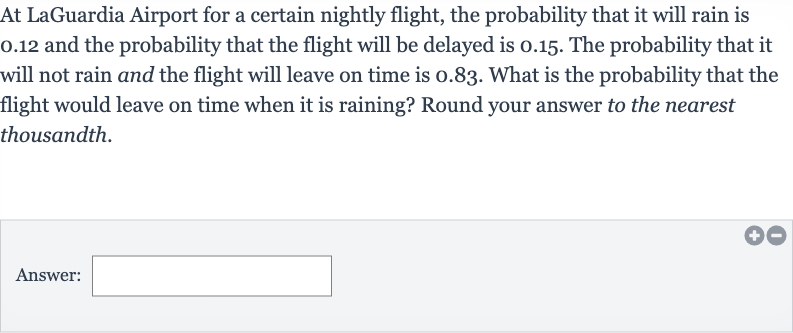AI tutor
Welcome to Bytelearn!
Let’s check out your problem:

At LaGuardia Airport for a certain nightly flight, the probability that it will rain is . and the probability that the flight will be delayed is . . The probability that it will not rain and the flight will leave on time is . . What is the probability that the flight would leave on time when it is raining? Round your answer to the nearest thousandth.Answer:
Full solution
Q. At LaGuardia Airport for a certain nightly flight, the probability that it will rain is . and the probability that the flight will be delayed is . . The probability that it will not rain and the flight will leave on time is . . What is the probability that the flight would leave on time when it is raining? Round your answer to the nearest thousandth.Answer:
- Events Denotation: Let's denote the events as follows:R: It will rain.D: The flight will be delayed.T: The flight will leave on time.We are given the following probabilities:We need to find the probability that the flight will leave on time given that it is raining, which is .
- Find Probability of Flight Leaving on Time: First, we need to find the probability that the flight will leave on time, which is . We can use the complement rule since we know , which is the probability that it will not rain and the flight will leave on time.However, we don't have directly, so we need to find it using the information we have.
- Find Probability of Flight Delayed: We can find by using the fact that is the complement of , the probability that it will rain and the flight will be delayed.We don't have directly, but we can find it using the probability of the flight being delayed, , and the probability that the flight will leave on time when it's not raining, .
- Find Probability of Flight Leaving on Time Given Rain: We can rearrange the above equation to find :We know , but we don't have directly. However, we can find it using the complement of .
- Find Probability of Flight Leaving on Time: Now we need to find , which is the complement of .
- Find Probability of Flight Leaving on Time: Now we need to find , which is the complement of .Using the value of , we can find :
- Find Probability of Flight Leaving on Time: Now we need to find , which is the complement of .
Using the value of , we can find :
Now we can find : - Find Probability of Flight Leaving on Time: Now we need to find , which is the complement of .
Using the value of , we can find :
Now we can find :
With found, we can now find : - Find Probability of Flight Leaving on Time: Now we need to find , which is the complement of .
Using the value of , we can find :
Now we can find :
With found, we can now find :
Now we can find , the probability that the flight will leave on time: - Find Probability of Flight Leaving on Time: Now we need to find , which is the complement of .
Using the value of , we can find :
Now we can find :
With found, we can now find :
Now we can find , the probability that the flight will leave on time:
Finally, we can find the probability that the flight will leave on time given that it is raining, which is :
(rounded to the nearest thousandth)
More problems from Find probabilities using the addition rule
QuestionGet tutor help
QuestionGet tutor help
QuestionGet tutor help
QuestionGet tutor help
QuestionGet tutor help
QuestionGet tutor help
QuestionGet tutor help
QuestionGet tutor help
QuestionGet tutor help
